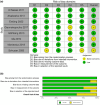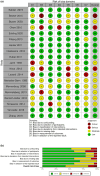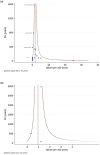Implant Survival in Patient Populations With a Mean Age of 65-75 Years Compared to Older Cohorts: A Systematic Review and Meta-Analysis
- PMID: 40485004
- PMCID: PMC12423580
- DOI: 10.1111/clr.14456
Implant Survival in Patient Populations With a Mean Age of 65-75 Years Compared to Older Cohorts: A Systematic Review and Meta-Analysis
Abstract
Objectives: To evaluate implant survival and success rates in elderly patients, comparing younger old adults (65-75 years) to older implant patients (> 75 years).
Methods: A systematic search was conducted using Medline, Cochrane Library, and PubMed Central for clinical studies on implant therapy in patients aged 65 and older. Outcomes included implant survival and success rates, peri-implant parameters, bone-level changes (BLC), and type of restoration and retention. Three- and five-year survival and success rates, as well as implant loss per 100 implant-years, were estimated with 95% confidence intervals (CI). Poisson regression models and incidence rate ratios (IRR) were used to compare study groups, and meta-regression with restricted maximum likelihood estimation (REML) assessed BLC.
Results: Twenty-seven studies with a total of 3892 implants were included. Patients > 75 years had significantly higher five-year survival rates (96.8%, CI: 95.9-97.5) compared to the 65-75 age group (92.1%, CI: 83.0-96.4; p = 0.031), with lower implant loss rates per 100 implant-years. No significant difference in success rates was observed (p = 0.229). Although plaque and bleeding on probing (BOP) were more frequent in the older group, there was no significant difference in BLC (mean difference: 0.41 mm; p = 0.189). In patients > 65 with implant overdentures, single attachments showed significantly higher implant loss rates than bars (p = 0.035).
Conclusions: Dental implants are a reliable treatment for older adults, including those over 75 years. Despite more frequent plaque and BOP in the older group, peri-implant bone remained stable. Splinting implants in overdenture wearers aged > 65 is associated with 5.6 times higher survival rates.
Keywords: advanced age; elderly patient; implant success; implant survival; meta‐analysis; systematic review.
© 2025 The Author(s). Clinical Oral Implants Research published by John Wiley & Sons Ltd.
Conflict of interest statement
The authors declare no conflicts of interest.
Figures






Similar articles
-
Interventions for replacing missing teeth: different types of dental implants.Cochrane Database Syst Rev. 2014 Jul 22;(7):CD003815. doi: 10.1002/14651858.CD003815.pub4. Cochrane Database Syst Rev. 2014. PMID: 25048469
-
Interventions for replacing missing teeth: different types of dental implants.Cochrane Database Syst Rev. 2005 Jan 25;(1):CD003815. doi: 10.1002/14651858.CD003815.pub2. Cochrane Database Syst Rev. 2005. Update in: Cochrane Database Syst Rev. 2007 Oct 17;(4):CD003815. doi: 10.1002/14651858.CD003815.pub3. PMID: 15674915 Updated.
-
Outcome of implant therapy in patients with previous tooth loss due to periodontitis.Clin Oral Implants Res. 2006 Oct;17 Suppl 2:104-23. doi: 10.1111/j.1600-0501.2006.01347.x. Clin Oral Implants Res. 2006. PMID: 16968387
-
Interventions for replacing missing teeth: different types of dental implants.Cochrane Database Syst Rev. 2007 Oct 17;(4):CD003815. doi: 10.1002/14651858.CD003815.pub3. Cochrane Database Syst Rev. 2007. Update in: Cochrane Database Syst Rev. 2014 Jul 22;(7):CD003815. doi: 10.1002/14651858.CD003815.pub4. PMID: 17943800 Updated.
-
Effectiveness of sinus lift procedures for dental implant rehabilitation: a Cochrane systematic review.Eur J Oral Implantol. 2010 Spring;3(1):7-26. Eur J Oral Implantol. 2010. PMID: 20467595
References
-
- Abou‐Ayash, S. , Fonseca M., Pieralli S., and Reissmann D. R.. 2023. “Treatment Effect of Implant‐Supported Fixed Complete Dentures and Implant Overdentures on Patient‐Reported Outcomes: A Systematic Review and Meta‐Analysis.” Clinical Oral Implants Research 34, no. Suppl 26: 177–195. - PubMed
-
- Al‐Nawas, B. , Bragger U., Meijer H. J., et al. 2012. “A Double‐Blind Randomized Controlled Trial (RCT) of Titanium‐13Zirconium Versus Titanium Grade IV Small‐Diameter Bone Level Implants in Edentulous Mandibles—Results From a 1‐Year Observation Period.” Clinical Implant Dentistry and Related Research 14: 896–904. - PubMed
-
- Alsabeeha, N. H. , Payne A. G., De Silva R. K., and Thomson W. M.. 2011. “Mandibular Single‐Implant Overdentures: Preliminary Results of a Randomised‐Control Trial on Early Loading With Different Implant Diameters and Attachment Systems.” Clinical Oral Implants Research 22: 330–337. - PubMed
Publication types
MeSH terms
Substances
LinkOut - more resources
Full Text Sources


